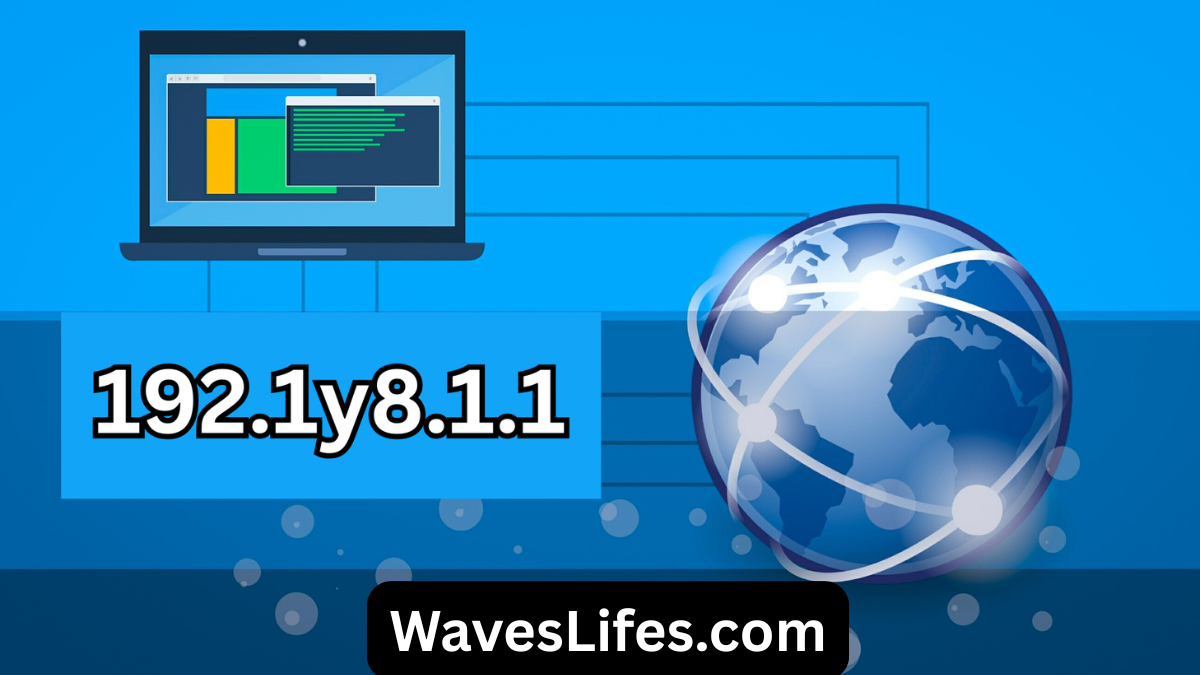192.1y8.1.1 In the digital age, IP addresses are fundamental to networking. Every device that connects to the internet uses an IP address to communicate with other devices. Occasionally, unusual IP-like terms like “192.1y8.1.1” begin to surface on forums, tech websites, or troubleshooting guides. While this sequence resembles an IP address, its actual meaning and function require clarification. This article dives deep into “192.1y8.1.1,” explores whether it’s a valid IP address, examines its possible origin, and explains what users should do if they encounter it.
Is 192.1y8.1.1 a Valid IP Address?
To understand the nature of “192.1y8.1.1,” it is essential first to grasp what constitutes a valid IP address. An IP address typically consists of four octets separated by periods. Each octet ranges from 0 to 255 and consists solely of numeric values. For instance, an IP address like 192.168.1.1 is commonly used in private home networks. In contrast, “192.1y8.1.1” contains a non-numeric character “y”, making it syntactically incorrect in the context of IPv4.
This anomaly immediately signals that the IP address format is invalid. Devices and web browsers attempting to interpret or connect to this address will fail to resolve it because it doesn’t follow standard internet protocol addressing formats. This raises the question: why would such a string be used or searched online?
Common Causes of Typographical Errors in IP Addresses
One likely explanation for the appearance of “192.1y8.1.1” is a typographical error. The intended IP address might have been “192.168.1.1”, which is one of the most commonly used default gateway IP addresses for routers and modems. In fast typing or poorly printed documentation, it’s easy for “168” to be mistyped or misread as “1y8”.
Such errors occur frequently when users try to access their router’s admin panel and mistakenly input the wrong characters into their web browser. Since web browsers interpret entered addresses as URLs or search queries, the typo may lead users to misleading results or confusion, prompting them to seek clarification about the address online.
The Role of 192.168.1.1 in Home Networking
Assuming that “192.1y8.1.1” is a corruption of “192.168.1.1,” it is helpful to understand the purpose of this commonly used address. The IP address 192.168.1.1 serves as the default gateway for many routers. It allows users to access the device’s admin panel, where they can configure network settings such as Wi-Fi name, password, firewall rules, port forwarding, parental controls, and firmware updates.
When users enter “192.168.1.1” into a browser, the router responds by displaying a login screen that typically requires a username and password. From this interface, advanced users and administrators can fine-tune their network settings for optimal performance or security. Misconfigurations here can disrupt connectivity, while careful adjustments can greatly enhance network stability and efficiency.
Troubleshooting Access Issues Related to Mistyped IP Addresses
Users encountering “192.1y8.1.1” are likely experiencing connection issues or trying to configure their router. Since the input address is invalid, their browser will not lead them to the correct configuration page. This results in error messages such as “This site can’t be reached” or “DNS_PROBE_FINISHED_NXDOMAIN.”
To resolve such issues, users should double-check the IP address they have entered and correct it to the proper format. In most home setups, the correct IP address to access the router’s settings is either 192.168.1.1 or 192.168.0.1. If that still fails, running the “ipconfig” command on Windows or “ifconfig” on Unix-based systems can reveal the active default gateway used by the local network.
Security Risks of Mistyped or Misleading IP-Like Strings
The use of a malformed IP address like “192.1y8.1.1” may not always be innocent. In some instances, cybercriminals and malicious websites exploit human error. They may create fake domains that closely resemble common IP addresses to mislead users. For example, entering a malformed address in a browser might redirect users to phishing pages designed to steal login credentials or personal information.
As such, mistyping something as simple as an IP address could have broader implications if the wrong site is accessed. Users are advised to exercise caution and ensure that they are entering correct and verified IP addresses, especially when dealing with network settings or sensitive configuration portals.
The Importance of Default Gateways in Network Communication
In networking, a default gateway is the node that routes traffic from a local network to devices outside the network, such as the internet. It acts as a gateway between a home or enterprise network and the broader world wide web. In residential environments, the router usually serves as this default gateway, and it typically uses IP addresses like 192.168.1.1.
Therefore, users need to input the correct gateway IP address to interact with the router’s firmware interface. If a user mistakenly types “192.1y8.1.1”, the system has no logical means to route the query, and the attempt will fail. Recognizing and correcting such errors ensures uninterrupted connectivity and proper network management.
Common Scenarios That Lead to Inputting 192.1y8.1.1
There are a few scenarios where the string “192.1y8.1.1” might commonly appear. One is during router installation or configuration by non-technical users. When copying settings from printed manuals or online forums, a misread digit or letter can easily be entered. Another possibility is mobile phone browsers’ auto-correct or predictive text features, which may inadvertently alter valid IP addresses.
In educational settings or DIY network setup videos, if poor audio or visual quality is present, learners might misinterpret the IP address being spoken or displayed. This further underscores the importance of clear communication and accurate transcription in technical materials.
Why Correct IP Input Matters in Network Configuration
Inputting the correct IP address is essential for configuring a home or business network. A wrong entry not only prevents access but may also waste time and create confusion. For businesses, improper configuration can lead to downtime, lost productivity, and potential data exposure if security settings are neglected due to misnavigation.
In the age of remote work and smart devices, maintaining smooth access to networking interfaces is more important than ever. A simple error like typing “192.1y8.1.1” instead of the valid “192.168.1.1” can delay important tasks or hinder device connectivity across the network.
Tools to Help Identify and Confirm Default Gateway IP Addresses
Operating systems often include built-in tools that can reveal your network’s default gateway. In Windows, opening the Command Prompt and typing ipconfig displays a list of IP-related information, including the default gateway. On macOS and Linux, the ifconfig or ip route command can serve the same purpose. These tools are invaluable when trying to locate your router’s address.
There are also mobile apps and third-party tools designed for network diagnostics. They often include IP scanner features that can identify devices on a local network, display their IP addresses, and highlight which device serves as the default gateway. Using these utilities can help prevent errors like misidentifying or mistyping your IP address.
Conclusion: Staying Aware of Typing Accuracy and Networking Fundamentals
The string “192.1y8.1.1” is not a valid IP address and is most likely a result of human error, such as a typographical mistake when attempting to access a router’s admin panel. Recognizing this allows users to avoid confusion and quickly correct their inputs. As networking continues to play a vital role in homes and businesses, understanding the basics of IP addressing, default gateways, and safe browsing practices becomes essential.
Being precise with IP addresses is not just a matter of correctness—it’s also about maintaining security and functionality across the devices you rely on 192.1y8.1.1 every day. Avoiding simple errors like typing “192.1y8.1.1” instead of the correct address ensures smoother network administration and helps users avoid unnecessary frustration.
FAQs
What does 192.1y8.1.1 mean?
The term “192.1y8.1.1” is not a valid IP address. It is likely a typographical error or misreading of the correct IP address “192.168.1.1”, which is commonly used as a default gateway for routers.
Can I access my router using 192.1y8.1.1?
No, you cannot access your router using “192.1y8.1.1” because it is not a valid IPv4 address. Use “192.168.1.1” or another valid IP depending on your router’s configuration.
Why does my browser say 192.1y8.1.1 is not reachable?
Your browser shows that the address is not reachable because “192.1y8.1.1” does not correspond to any real IP address. Correct the input to access your router’s admin panel.
How can I find the correct IP address for my router?
On Windows, open Command Prompt and type ipconfig, then look for “Default Gateway”. On macOS or Linux, use ifconfig or ip route to find your router’s IP address.
Could “192.1y8.1.1” be dangerous?
If entered in a browser, this string might be interpreted as a search term or redirect to unrelated websites. While it’s not inherently dangerous, be cautious of any websites that use misleading names resembling IP addresses, as they may be fraudulent.
Is 192.168.1.1 the same for all routers?
No, although many routers use 192.168.1.1 as their default gateway, others might use addresses like 192.168.0.1 or 10.0.0.1. Always check your specific device’s manual or use system tools to confirm.
What should I do if I cannot access my router using 192.168.1.1?
Ensure you are connected to the correct network, 192.1y8.1.1 and verify the IP address using a command-line tool. If the address is still unreachable, restart your router or contact your ISP for assistance.
Why do mistyped IP addresses matter?
Mistyped IP addresses lead to failed connections and can result in confusion or security risks if they direct you to suspicious domains. Always double-check for accuracy when configuring networks.




